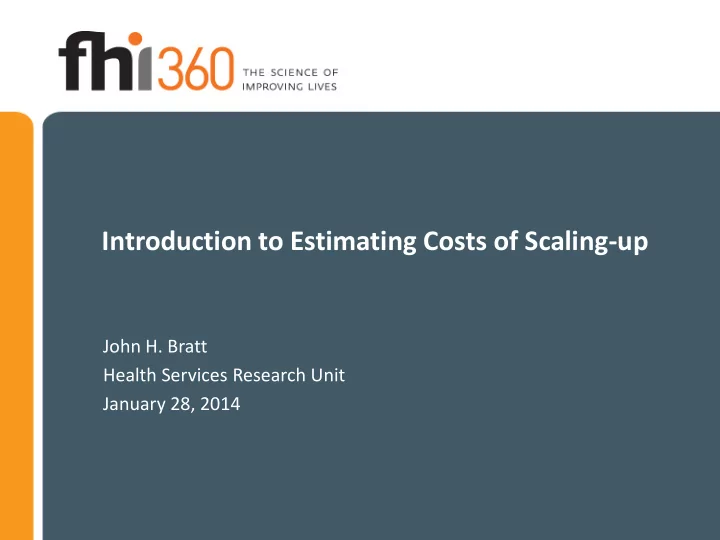

Introduction to Estimating Costs of Scaling-up John H. Bratt Health Services Research Unit January 28, 2014
Why Estimate Costs of Scaling Up? Because someone inevitably will ask “How much will it cost to scale this up?” Generate support for resource mobilization • “US$800 per service delivery point at scale” • “US$1.50 per beneficiary per year” Inform the planning and budgeting process • Forecast overall resource needs • Provide structure for creating activity budgets Identify potential issues with financing • Feasible to scale up program/practice? • Will program/practice be sustainable at scale?
FHI 360 Approach to Estimating Costs of Scaling-up 1. Measure costs of pilot project (preferably during implementation) 2. Work with stakeholders to specify how implementation of program/practice at scale would differ from pilot project 3. Translate these adjustments into cost terms
Incremental Costs Associated with Interventions Interventions that become “Best Practices” often begin as small pilot projects carried out Incremental within an existing program Costs When costing a pilot intervention, the focus is on Program Costs incremental costs
Economic Taxonomy of an Intervention Phase Activity Resource Cost
Costing the Pilot Intervention Identify resources used for each activity (labor, supplies, capital) Measure resources in natural units – hours, items, days of per-diem Assign unit value to each resource – wage rate, unit cost Cost calculation for activity – Σ (quantity of resource x unit cost)
Example: Four Activities in “preparing for service delivery” Phase • Intervention staff conduct ToT • Trainers train CBAs in central location • Improve supervision system • Improve logistics system for commodities
Costing an implementation activity: “Trainers train CBAs” Resource Quantity Unit Cost Total Trainer time 5 person-days $120/day $600 Food/Lodging 24 person-days $80/day $1,920 Venue fee 3 days $60/day $180 Trainee time 21 person-days $8/day $168 Grand Total $2,868
Total Costs of Implementing the Plan Activity Quantity Unit Cost Total ToT workshop 1 $1,880 $1,880 CBA workshop 3 $2,868 $8,604 Supervisor training 3 $200 $600 Logistics upgrade 3 $85 $255 Total cost of “implementing the plan” $11,339
Estimating Costs of Scaling-up Can we estimate scale-up costs simply by multiplying per-site costs of the pilot by the number of scale-up sites? • For example: assume that a pilot Scale-up Costs are project cost $2500/clinic, and plans Not Simple are to scale up to 40 clinics. Multipliers of the • Therefore, can we assume that the Costs of Pilot cost would be $2500 x 40 clinics = Projects!! $100,000?
Scale-up Costs are not simple multipliers of pilot costs: four main reasons • Pilot components not repeated in scale-up • Economies of scale • Differences in entity providing inputs • Changes in intervention content or program Source: www.popcouncil.org/pdfs/frontiers/pbriefs/PB08.pdf
1. Pilot Components Not Repeated in Scale-up Some planning elements are one-time activities and do not need to be repeated – Curriculum design – Stakeholder buy-in meetings with national health authorities
2. Economies of Scale Definition: Reduction in cost per unit resulting from increased production and operational efficiencies – Example: you trained 10 individuals per training in the pilot, but could actually train 30 individuals per training – Average cost per trainee ~ 1/3 of Pilot cost
3. Differences in Entity Providing Inputs Input costs may differ from those used in pilot – For example, if pilot used expensive international consultants for ToT, but the MOH will run activities when taken to scale, lower-cost staff are substituted for higher-cost staff – Non- financial costs in the pilot (‘economic costs’) may become financial costs at scale.
4. Changes in the Intervention • Different priorities in new context – Scale-up may choose to emphasize certain activities based on relative effectiveness and/or changes in priorities. – As mix of activities changes, so will the costs of scaling up a modified intervention • Some activities are deemed as not financially realistic at scale – Example: agency implementing scale-up cannot afford intensive supervision during routine service delivery
Take-Home messages • Increasing calls to justify interventions and programs on “value for money” criteria • Disaggregated cost of a pilot project is a good starting point for estimating scale-up costs • But scale-up costs are NOT simple multipliers of costs of pilot projects • Estimates of scale-up costs have many practical uses beyond the obvious
Thank You
Recommend
More recommend